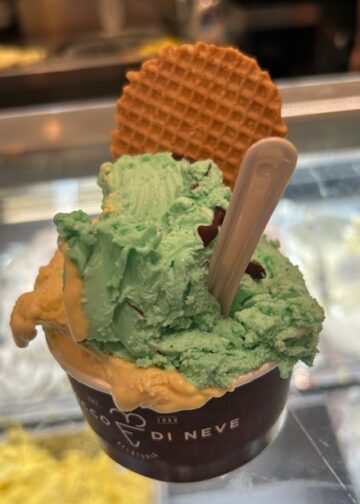In spite of gelato’s popularity worldwide, Italy is the only country where the market share of handmade gelato versus the industrial one is over 55%. Today, more Italy’s 40,000 artisan gelaterie employ over 150,000 people, mostly Italians.
Since 2024’s summer, already sizzling by mid-May, is expected to surpass 2023’s as the hottest summer in recorded history and next year Italy will host between 30 and 35 million pilgrims for Holy Year, here’s an itinerary for the best venues of Italy’s quintessential, ubiquitous, refreshing dessert, all sampled by me, a lifelong appassionata.
Rome, my “hometown”, is home to the largest number of Italy’s artisanal gelaterie, almost 2,000. Moreover, Romans consume 19 kilos of gelato per capita annually as opposed to 12 kilos in other major cities.
Rome’s neighborhood around the Pantheon has the highest concentration of top artisan gelaterie: Fiocco di Neve, where the ice cream and cones are gluten-free, best flavor: eggnog; Della Palma, 150 flavors including Irish coffee, basil and baba; San Crispino (branches on the Trevi Fountain Square and near St. John in Lateran, white peach and meringue); Ciampini (outdoor seating in atmospheric Piazza San Lorenzo in Lucina, for chestnut) and Giolitti (outdoor and elegant indoor seating, open 365 days a year since 1890, 100 flavors all tops, if you don’t mind a long wait.

Near St. Peter’s: V-Ice (5th bus stop (nos. 98, 881, 916) uphill at Via Gregorio VII 385 or downtown, branch on Corso V. Emanuele II, pistachio); Cremeria Aurelia (5th stop (no. 46) uphill at Via Aurelia 398, all seasonal fruits and spices; Gelateria dei Gracchi, almond all’ orange and chocolate with rum; Gelateria Oldbridge near the Vatican Museums; Hedera (Borgo Pio 179), hazelnut, pistachio, and licorice.
Near Piazza Navona: Gelateria del Teatro, chocolate al nero d’Avola (Sicilian red wine), chocolate with basil or sage, raspberry); Il Gelato di Claudio Torcè, over 100 flavors, most bizzare: gorgonzola with vinegar, ricotta with coconut, and chocolate with pink salt from the Himalayas.
Near St. John in Lateran: Besides San Crispino, Procopio, all fruits especially mango; Petrini, chocolate.

Worth a detour: Al Settimo Gelo (Via Vodice 8, fig; Tony (Largo Alberto Missiroli 15-17, specialties: “gli spaghetti” and “un uovo al tegamino” (fried egg), best flavors: nutella, pistachio, bacio and pinolata (pinenut); Mondi, indispensabile.
In 2024 I’ve traveled to Florence, Naples, Torino and Venice. In Florence I can heartily recommend: Vivoli near Santa Croce, best flavors: zabaione, crema, and riso; Perchè No!, a 2-minute walk from the Duomo for coffee crunch with pieces of chocolate, and La Carraia across the Arno for its Delizia; in Naples Casa Infante for its buffalo ricotta mixed with caramelized figs from the Cilento, and in Torino hands down Alberto Marchetti. Venice is too touristic for recommendations.
Elsewhere, the choice is overwhelming. I’d have to live another 100 years to cite the best, but no valid gelaterie itinerary of Italy can omit Il Massimo del Gelato in Milan, Gallieria 49 in Bologna or Dolce Capo in Palermo.
Since every gelateria invents many flavors of its own, it’s strange that the “classic” flavors are still the favorites. According to a recent survey conducted by Eurisko in Italy, 27% of the participants preferred chocolate, 20% hazelnut, 13% lemon, 12% strawberry, 10% vanilla, 9% stracciatella or chocolate chip, and 8% pistachio.
If you’re tempted to become a professional gelato artisan and run your own gelateria, enroll at Carpigiani Gelato University (www.gelatouniversity.com) in Anzola dell’Emilia near Bologna, either on site or online. Set up by ice cream machine maker Carpigiani in 2003, it offers over 500 courses for beginners to experts, taught in Italian, English, French, and Spanish ranging from 5 (cost 1.708 euros without board) to 20 days (6.100 euros without board). So far approximately 5,000 students a year from around the world have attended on site. Carpigiani also has campuses in Australia, South Korea, Japan, Belgium, Scotland, England, United States in Illinois and North Carolina, and Argentina.

For attendees of the one-day course (122 euros) and for history buffs like me, the university building also houses the world’s only Museum of Gelato. Here you’ll learn that gelato may date to the reign of the Roman emperor Nero (37-68 A.D.) or to around 400 A.D. in Arabia. Others say that “The Father of Gelato” was a Sicilian fisherman, Procopio Cutò (1651-1727), who brought gelato to France. Before leaving Sicily, he perfected the first ice cream machine, his grandfather’s invention. Upon his arrival in Paris Procopio worked as an apprentice for the Armenian immigrant Pascal who owned a kiosk selling lemonade and coffee on Rue de Tournon. In 1675 Procopio took over the kiosk and in 1686 founded the first literary coffeehouse in Paris, the oldest extant café, Café Procope, across the street from the Comédie-Française.












